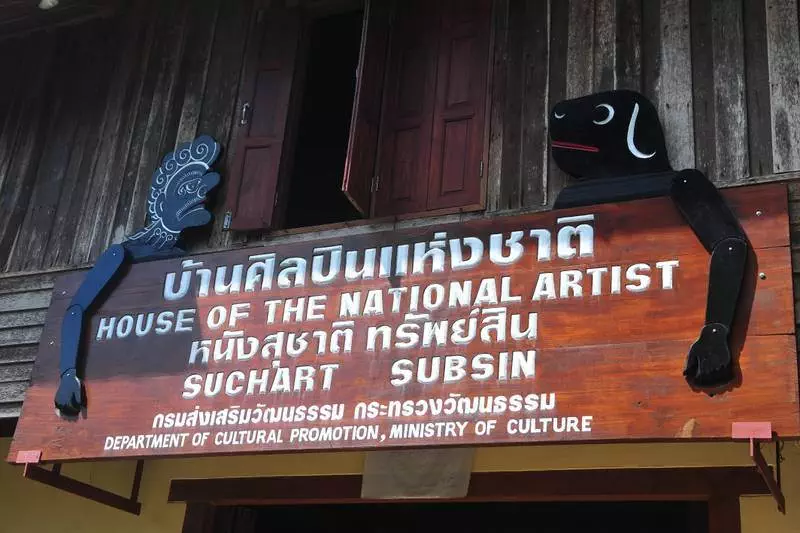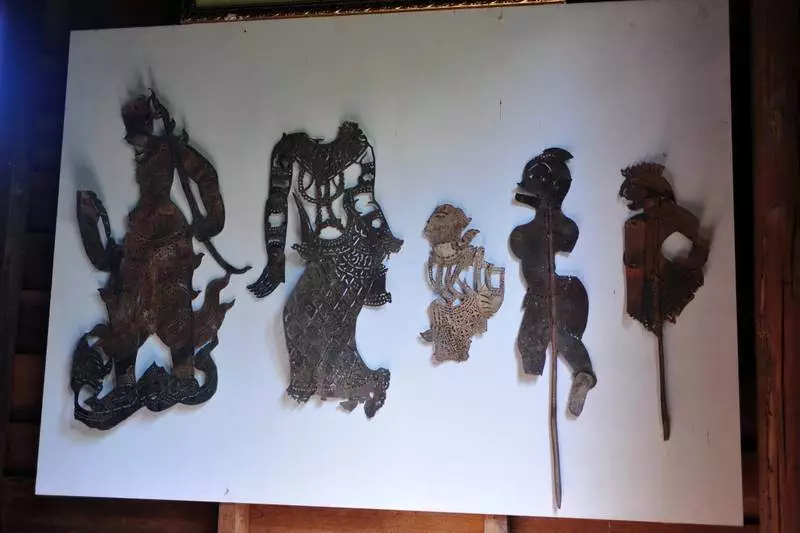Shadow play and shadow puppets used to be the way to tell a story.
 With all the technological advances made in recent times, it can be interesting to see how stories were told long ago. Founded in 1987, the home of National Artist Suchart Subsin is now a small museum — a rather humble collection of his artistic legacy. To get this story started, however, we need to go all the way back to 1938.
With all the technological advances made in recent times, it can be interesting to see how stories were told long ago. Founded in 1987, the home of National Artist Suchart Subsin is now a small museum — a rather humble collection of his artistic legacy. To get this story started, however, we need to go all the way back to 1938.
Born in 1938, Suchart Subsin showed a talent and interest in Nang Talung, or shadow puppet play, since his early childhood. After learning to draw the patterns and Thai styles, he became a professional artist at 14. To say it’s been his life’s work is an understatement — between making shadow puppets and teaching others how to make them, he’s been awarded for his cultural preservation efforts dozens of times over. Being called a National Artist means being regarded as one of the very best in the field. His son, Wathi Subsin, carries on the tradition, which includes the use of five traditional Thai instruments only — no Western instruments.

You won’t see the awards hanging on the wall, however. You won’t see much that alludes to the very modern time we live in. In fact, just stepping foot on the museum’s ground feels like you’ve gone back in time to the 1950’s or 1960’s. That’s thanks in part to the traditional (rustic?) buildings still standing. The two you’ll pay attention to are in essence the museum (above), and the souvenir shop / demonstration area, which you’ll get to in due time. For now, take off your shoes and head up the steps to the museum.

There’s just enough English in the museum to be of help, though the staff can also provide a sheet with more information in English. The plane puppet above dates from World War II, which caused the puppets and screens to shrink so as to avoid being bombed.

A small but significant difference: shadow puppets of women have translucent faces — the shining light is considered a feminine trait.

Plenty of different types of shadows were used, but nang talung puppets were typically small. Plots would be focused around a family conflict, the tales of a traveler, star-crossed lovers, the teaching of magic, and so on. Whether mystical or historical, the notion of karma, rewards for good behavior and punishments for bad behavior fit into the Buddhist mindset. Other puppets are from India, China, Indonesia, and Turkey.

Exhibits aren’t just from Thailand — these Cambodian puppets come from the Siam Seap province and help to tell the Ramakien story.
 With the museum now done, head into the other building for a brief demonstration of how an artist works with the hide. A demonstration may include punching out holes for light to shine through and/or painting the hide — either way, it’s an look into the traditional methods used with very few modern adaptations.
With the museum now done, head into the other building for a brief demonstration of how an artist works with the hide. A demonstration may include punching out holes for light to shine through and/or painting the hide — either way, it’s an look into the traditional methods used with very few modern adaptations.
While you’re here, consider picking up anything from a postcard (15 baht) to a large puppet (3,500 baht). Also, if you found this museum interesting, there’s another museum in Ratchaburi (central Thailand) offering a free look at nang yai, the larger version of the shadow puppets. See Tour Bangkok Legacies for more information.

If you’re into history and culture, this is worth at least an hour of your time in Nakhon Si Thammarat. It’s probably not the best for kids, but it’s fairly easy to reach and on most maps.
Name: Nang Talung Museum (Ban Nang Thalung Suchart) (พิพิธภัณฑ์พื้นบ้านหนังตะลุง)
Address: 6 Soi Si Thammasok 3, Si Thammasok road, Nai Mueang, Nakhon Si Thammarat, Thailand, 80000 (GPS: 8.414438, 99.968682)
Directions: With your back to the Nakhon Si Thammarat train station, walk away from the train station and 100 meters towards Ratchadamnoen Road. Take a right and hop on a songthaew or walk for about 3 kilometers. You’ll be getting close when you pass the municipal hospital — at the four-way intersection just past the hospital, take a left onto Phan Yom (from here it’s walkable). Walk about 120 meters to the T, then turn right onto Thanon Si Thammasok — this road and Ratchadamnoen run parallel to each other, so try this road for songthaews if you don’t see any on Ratchadamnoen. Either way, go about 100 meters and look left for the museum.
Hours: 9am-5pm, open everyday
Admission: free (donations encouraged)
Phone: 075–346–394
Website: none


